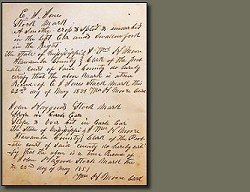 Over the years while researching various family lines, I’ve used census images probably as much as any record group. Census research can be fascinating yet problematic. I’ve come across several instances where the subject I was researching was not included in the census and some cases, where the subject was listed more than once in a particular census, but in a different location. I’ve come across many instances where ages were wrong and names were wrong. It’s always important to note that information gathered in a census was gathered by a human. But humans make mistakes. It is also important to know that in many cases information found in enumerations were not necessarily obtained directly from the family being enumerated.
Over the years while researching various family lines, I’ve used census images probably as much as any record group. Census research can be fascinating yet problematic. I’ve come across several instances where the subject I was researching was not included in the census and some cases, where the subject was listed more than once in a particular census, but in a different location. I’ve come across many instances where ages were wrong and names were wrong. It’s always important to note that information gathered in a census was gathered by a human. But humans make mistakes. It is also important to know that in many cases information found in enumerations were not necessarily obtained directly from the family being enumerated. A few years back, I was researching the Stephen Duncan family of Mississippi and Louisiana for a research paper, when I noticed errors with the 1860 census listing in relation to the John Julius and Maria Linton Duncan Pringle household. Some children were omitted, ages were wrong, the wife’s name was wrong, and some children added to this family in this particular census. This family lived on Torwood Plantation in Pointe Coupee Parish, Louisiana. However, Maria, the wife, was enumerated on the 1860 census at Auburn, her father’s family estate in Natchez, Adams County, Mississippi (Page 118, 863-863) upriver from Pointe Coupee Parish. This Adams County census was taken 20 July and the census of Torwood Plantation in Pointe Coupee Parish, Louisiana was taken on 18 July. According to the book Mary's World: Love, War and Family Ties in 19th Century Charleston, by Richard N. Côté, Julius and Maria left the states on a trip to France in July of 1860 leaving Torwood under the care of the overseer (page 202). I am wondering if Torwood's overseer or house servants in Pointe Coupee Parish answered the census questions, as the Pringle family members were probably away at the time and possibly those listed are the overseer's family? Or if simply, the overseer or person supplying the information was wrong and simply guessing at the information? This census listing continues to definitely a mystery for me.
The above is but one such example of census research problems. However, there is one avenue of study that can greatly enhance census research – and that is studying the actual census instructions for the various census years. It is always important to view the actual assistant marshals’ instructions for a particular census to fully understand the census process for that particular census year. For instance, during the 1850 census part of the instructions about enumerating household residents reads: “The name of any member of a family who may have died since the 1st day of June is to be enumerated as if living, but the name of any person born since the 1st day of June is to be omitted.” According to these instructions, if the enumerator visited a household on July 20, 1850 and your ancestor had died on May 10, 1850, the deceased ancestor would be enumerated as if still living. If a child had been born in the household on June 10, 1850 and the enumerator visited the household on August 1, 1850 the child would not be enumerated.
An excellent well-illustrated guide to the decennial censuses complete with questionnaires and instructions for each census is the publication, Measuring America: The Decennial Censuses From 1790 to 2000. This 140-page publication is in PDF format and available from the U.S. Census Bureau. This free publication can be downloaded in segments. The segment containing pages 5 through 96 deals with questionnaires and instructions given the enumerators from the 1790 census through the 1990 census and is a 3.07 megabyte download. This illustrated section is chock-full of detailed information about the 19th Century census taking process and is an important resource for genealogical researchers well worth the download time.





No comments:
Post a Comment